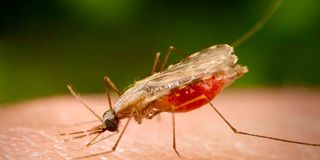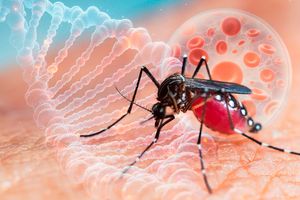Genetically modified mosquitoes: What you need to know

Djibouti is one of the countries that has introduced genetically modified (GM) mosquitoes to stop the spread of Anopheles stephensi.
What you need to know:
- Grey Frandsen, the CEO of Oxitec, explains how the GM mosquitoes are created, their efficacy and what this means in efforts to combat malaria in Africa, where more than 90 per cent of malaria cases and deaths are recorded annually.
In May, Djibouti became the second country in Africa after Burkina Faso to release genetically engineered mosquitoes in a pilot phase programme. This was due to a resurgence of malaria in the Horn of Africa nation that had nearly eradicated the disease 12 years ago.
In 2012, there were just 27 malaria cases detected in Djibouti, but by 2020, the number had risen to 73,000.
The return of malaria in Djibouti is due to the Anopheles stephensi mosquito species. This species is typically found in Asia but has since made landfall in the horn of Africa, leading to a spike in malaria cases. Research has revealed that Anopheles stephensi is rapidly spreading across urban areas, bites during the day and is resistant to the chemical insecticides used to kill mosquitoes.
UK-based firm Oxitec is behind the release of the genetically modified (GM) mosquitoes dubbed ‘Friendly mosquitoes. Grey Frandsen, the CEO of Oxitec, explains how the GM mosquitoes are created, their efficacy and what this means in efforts to combat malaria in Africa, where more than 90 per cent of malaria cases and deaths are recorded annually, according to the World Health Organization.
Who is Oxitec and how long have you been providing biotechnology solutions in health?
Oxitec is an organisation based in the United Kingdom. It was founded 22 years ago by scientists at the University of Oxford, who determined there was significant need for a new approach to combat invasive species and disease-spreading mosquitoes. They came up with a solution that uses genetic engineering to make two adaptions to mosquitoes to make them harmless. Those adaptions allow the release of friendly males that do not bite. We then release those males to seek and mate with wild females from the same species only and from that mating, all the female progeny die. The concept of using a mosquito to fight mosquitoes has revolutionised how the international public health community views the approach to malaria, dengue or yellow fever. We have a team of 200 people from 15 countries. Our technology platform has been developed by dozens of public nonprofit academic partners form around the world and now it is time to have an impact
What is in the Friendly mosquitoes that makes the females they mate with die?
We introduce two genes into a male mosquito to make it “friendly”. One of those genes is a female specific adaptation to the DNA that allows the males to pass on genes that are triggered only with the female genetics. It’s like a small switch that triggers the over-production of a safe protein in the female mosquito that then causes its death. We have done this for more than 10 years with guidance and oversight from regulators like the US Environmental Protection Agency, Food and Drug Administration, Brazilian regulators and Djiboutian regulators. This technology has been proven safe and effective.
How did Oxitec find itself in Djibouti? Who initiated your collaboration?
Djibouti was near elimination of malaria in 2012. It was a remarkable achievement up until that point. Unfortunately, a new invasive mosquito called Anopheles stephensi from South Asia and Middle East invaded Djibouti and began spreading malaria rapidly in urban environments. The challenge with this mosquito is that it is a daytime biter, a city biter and it is resistant to most chemical pesticides, so bed nets do not work because the mosquito is biting throughout the day. This is new in Africa, where malaria is mostly prevalent in rural areas. The invasive Anopheles stephensi species becomes a perfect storm of a public health crisis.
We were invited by the Djiboutian government to find a solution for that particular mosquito. We have done our first pilot release of the friendly mosquito in Djibouti at a small scale and are preparing for full field pilots later this year and early next year, where we will begin generating data about its effectiveness.
This means that you do not have any data generated so far from the May release?
We do not have any data yet for Anopheles stephensi. However, Oxitec has been studied for more than 15 years by academic and scientific communities, and there are more than 100 peer-reviewed scientific publications on our technology. In Brazil, we are nationally scaling up commercial solutions with friendly mosquitoes and have achieved over 90 per cent suppression in areas where we target that particular disease vector. We have expectations that our Anopheles stephensi solution will deliver the same effectiveness in Djibouti.
If mosquitoes are developing resistance to conventional pesticides naturally, what makes the genetic- engineered mosquitoes “immune” to naturally adapting to the environment and becoming the very problem they have been created to solve?
The wild Anopheles stephensi is not supposed to be in Africa and it is now spreading disease to many cities and urban centres. It needs to be controlled. When you introduce an Oxitec friendly mosquito, it is a closed-loop system. Unlike GM crops that require refuge (non-GMO crops) to control resistance by imposing pests threats, Oxitec mosquitoes only mate with their counterparts in the wild. We have proven scientifically with regulators around the world that our technology does not only create resistance among the target population,. We are not making a permanent adaptation to the local environment, rather targeting an invasive species that does not have an important role in the ecosystem.
Gene editing is the latest frontier in biotechnology. Has Oxitec employed this technology with the friendly mosquitoes or are there other solutions you are developing with gene-editing?
Gene editing is a process of knocking out a couple of genes with scissors-like precision to remove a particular gene or two to achieve a desired effect. For friendly mosquitoes, we use two genes inserted into the male mosquito.
How do you build local trust in the countries you are working with here in Africa at a time when there is a lot of fear and aversion with regard to biotechnology; be it in health and agriculture?
Everything we do is in collaboration with the local community. We start there and build trust such that they accept the use of these technologies and actually become part of their deployment. We want to empower communities to use these technologies. It’s not some European group parachuting in, these are Djiboutians, Kenyans and Ugandans fighting against malaria in a new way because we now have the tools to do so.
When will you be launching friendly mosquitoes in Uganda?
Earlier this year, we received an invitation and commitment from the government of Uganda through President Yoweri Museveni and his team to help develop a friendly Anopheles funestis mosquito. It is not a problem in Kenya.
The affected regions include Uganda, Tanzania and a little further south to the coast. This mosquito is a key link in the annual transmission of malaria. It lives in large water bodies, lakes and big ponds that do not dry up during the dry season.
We are going to use the same technology we have used with Anopheles stephensi in Djibouti. For the first time in our history, an African country - Uganda - will be funding the development of a technology with our platform.
What role does climate change play in worsening public health crises like malaria and how will bio-engineered solutions fit into this matrix?
Climate change is driving the spread of invasive disease-spreading mosquitoes to new regions and territories at an unprecedented level. This is a result of increased transportation, rapid urbanisation and change of human behaviour. We have overused chemical pesticides and mosquitoes have learnt to get around them. We need to rethink new strategies of combating these diseases.





